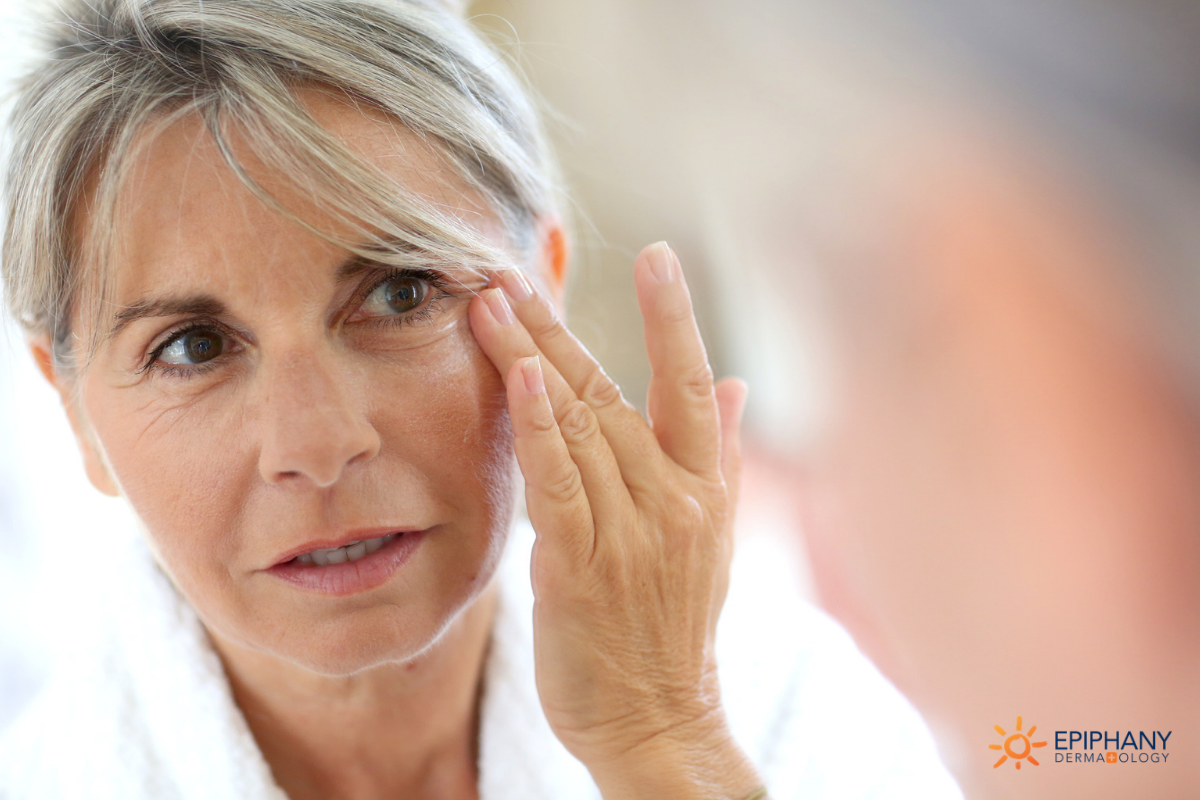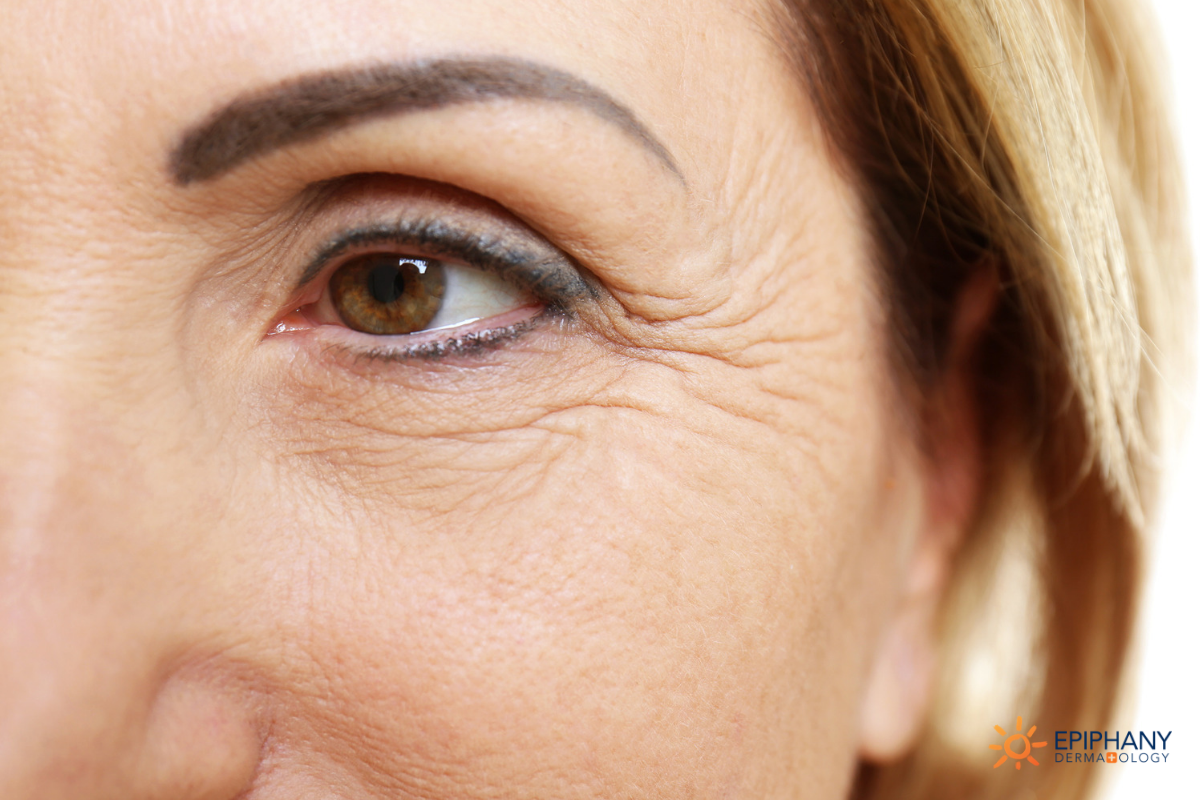We all have emotions. We make expressions — that’s part of being human. We laugh, cry, frown, smile, raise our eyebrows, and crinkle our noses.
But how do we keep responding to life as any human would, and not end up with smile wrinkles and wrinkles around our eyes?
It may not be possible to avoid wrinkles altogether, but once we understand the types of wrinkles and what affects them, we can set our skin up for success.
Two Different Types of Wrinkles
There are two distinct types of wrinkles: dynamic and static.
Dynamic wrinkles happen at all ages — even kids can have dynamic wrinkles. These are temporary. Your facial muscles move and create lines, but then they disappear.
When you get upset, cry, or even have a particularly stressful day, you’ll notice them even more, but after a good night’s sleep, they disappear.
Static wrinkles are the dreaded lines that don’t go away — even when you’re rested and refreshed. You wake up in the morning after a good night’s sleep, but when you look in the mirror the smile wrinkles or wrinkles around your eyes remain.
These lines haven’t disappeared with sleep and relaxation. They’re here to stay. Even when you’re not moving the muscles directly responsible for creating the wrinkles, they persist.
How do you know what type you’re dealing with? Look carefully at your lines at night. If they’re still there the next morning — even after a full night’s sleep — they’re static. If they have disappeared, they’re dynamic wrinkles.
When Do Wrinkles First Appear?
For most us, the static type of wrinkle shows up when we’re in our 30s because while we’re making unconscious expressions, lines start to form.
Often it’s the lines from our furrowed brows and squinting we notice first. We furrow our brow as we stare at the computer, we squint when we’re driving or in the time we spend outside running, fishing, or watching sports. And if you don’t wear sunglasses, you probably squint even more.
These expressions lead to the first wrinkles appearing in the form of “concentration face” (aka crow’s feet), creating wrinkles on the lateral part of the eye and cheek area.
Wrinkles in my 20s? Am I doomed?!
Occasionally, we see wrinkles in the 20s — but usually, these are dynamic wrinkles which disappear with a little rest. But sometimes it seems that literally the day you turn 30, the static wrinkles show up.
If you notice wrinkles around the eyes in your 20s that aren’t fading overnight, you may be dealing with the early development of static wrinkles.
We often see early static types of wrinkles in fair-skinned people. Yes, there’s a genetic component that makes fair-complected, light-eyed, light-haired people predisposed to earlier static wrinkles, but it’s not the only factor.
So much of a youthful look depends on volume in the face. If you’re exercising often, particularly if you’re exercising outdoors, you may see static wrinkles a little earlier. Or, if you spent much of your teen years exercising outdoors — think playing high school sports — those lines may appear a little earlier for you as well.
Smoking can also decrease volume in your face. It zaps the collagen, causing your face the thin out and show wrinkles more easily.
Related: 4 Everyday Habits That Are Giving Your Skin Creases
Does Skin Tone Affect Types of Wrinkles?
We know there’s a genetic component to wrinkles, but wrinkles mostly result from sun exposure. If you’ve pampered your skin because you know it’s sensitive to the sun, you’ve probably also done a great job at preventing wrinkles.
If you’ve let your skin burn repeatedly, or if you’ve assumed your skin can handle the sun because you tan easily, you’ve primed your skin for lines and wrinkles.
Want to know who usually takes the best care of their skin in the sun?
Redheads.
If you have red hair and the stereotypical skin tone to accompany it, you’re probably on the right track to preventing wrinkles. You likely learned early to either wear a hat or sunscreen if you’re going to be outdoors. Otherwise, you burn.
As the father of a redhead, I know how this works. Yes, you have paler skin, but because you’ve had to be careful since childhood, you’re less likely to see the early onset of wrinkles.
What if you’ve always tanned well?
If you’re “sneaky-skinned” like me, you may have adopted a false sense of confidence as a kid. You tanned well and didn’t seem to burn much. However, some of us have a lurking freckle gene triggered by that sun damage.
The older we get, the more sun damage shows on our skin. Your skin looked great while you were young, but now freckles seem to take very little prompting.
The ability to tan as an adolescent or early adult often predisposes you to wrinkles and sun damage. Now, even during your adult “working-in-an-office” life, you notice freckles, sun spots, and wrinkles. This also indicates you have an increased risk of skin cancer. You’ll spend the next six decades dealing with the effects of the first two.
 Treating Wrinkles At Every Age
Treating Wrinkles At Every Age
The best way to treat wrinkles is to prevent them. Here’s what to look for specifically at different ages.
Under 18
Parents, this is your job. You may not be able to turn back time, but you can set your child up for better skin. Sunburns are DNA damage — and they’re never okay. They are the dreaded complication of too much sun and set your child up for skin complications later in life.
- Make your child wear sunscreen during any time spent outdoors. Most importantly, avoid sunburns.
20’s
You may see a few dynamic wrinkles at this point, but even if you don’t, prevention is key. Begin a concerted effort to prevent and reverse sun damage. You are in charge of the health of your skin now.
How can you prevent sun damage? It takes only two simple steps:
- Use a moisturizer each morning that contains sunscreen. We recommend products like Elta MD that use zinc oxide as the key ingredient to block UV rays.
- Use a retinoid product at night. Retinoids increase your cell turnover and help your skin heal. This starts reversing the damage you did before you knew better. You’ll need some guidance about which medication to use — different skin types tolerate different strengths of medicine. Talk to your dermatologist about the right strengths for your skin.
30’s+
For some of you, it may seem too late — it’s not.
Keep, or start, preventing new wrinkles from forming.
- Wear sunscreen every day. Use a zinc oxide product that physically blocks UV rays.
- Avoid sunburns at all costs. Again, burns damage your DNA and they’re never okay.
- Use a retinoid product at night. Your dermatologist can help you find the right strength and frequency for your skin.
- Consider treatment for your static wrinkles. Botox, lasers, chemical peels, and dermal fillers each have their place in treating wrinkles. They can be effective for both younger and older patients, depending on their specific area of wrinkles.
Botox for Wrinkles
Botox is one of the most frequent treatments people choose for wrinkles. This is a very effective treatment for wrinkles around the eyes or between the eyebrows. Since this is the first place people often see wrinkles, it’s usually one of the first treatments they consider.
Patients first noticing wrinkles that don’t disappear often ask, “Am I going to have to do this every three months for the rest of my life?”
This is a fair question. We naturally think, “I don’t want to start something I can’t keep up — either because of time or money.” But the answer is complicated because if we don’t intervene, the wrinkles are going to persist or worsen.
I usually recommend trying Botox, then repeating the treatment in about three to four months when the first treatment wears off.
With two good treatments, you’ve changed the skin for over half a year. During that time, the skin has smoothed out. We can also add topical products like Retin-A to rejuvenate the skin.
After those six months of intentional treatment, you may not need Botox every three months.
It’s possible that because of the treatment you’ve broken the unconscious habit of making facial expressions that were driving the creation of new static wrinkles, and you’ve taken steps to correct the damage.
Life is full of smiles, frowns, and surprises. You’re naturally going to make expressions, but they don’t have to result in wrinkles that last a lifetime.
Take the steps necessary to prevent sun damage and reverse the damage already done. If you’re interested in treating your wrinkles, give us a call and we’ll find the best option for you.

Dr. Christopher Fuller is a board-certified dermatologist in Keller and Roanoke, TX. After three years of general practice with the Marines, Dr. Fuller found himself drawn to the highly specialized field of dermatology. He pursued a residency in dermatology and was recognized as Chief Resident during his final year of training. A member of the American Academy of Dermatology, Dr. Fuller is skilled in practicing medical, surgical, pediatric, and cosmetic dermatology.
Learn more about Dr. Fuller.


